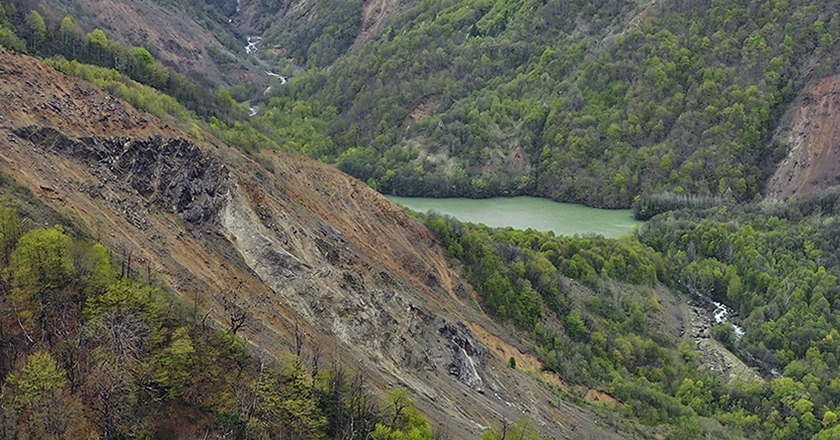Zhuzhuna Beridze was a nurse on duty that day.
„It was around 1:00 pm. I was waiting for a woman to bring a child, and suddenly it hit. I heard a tremendous noise and grasped a wooden fence to stay on my feet“.
„My neighbor threw me in the basement. Later I saw houses swaying. Then we learned Khakhieti was no more. So we went there and saw two mountains covering what was once the village“.
Khakhieti was situated at the mountain base, 1090 meters above sea level. Twenty families of ethnic Ossetians lived there. Only several people who were outside the village lived.
Valodia Beridze, 82, a resident of Perevi, recalls what he heard from Khajumar Gagiev. He was on his way to Khakhieti when the earthquake hit. He lived, but his wife and their child were lost.
„I was returning from Sinaguri. So close to the village, the wave hit me and threw me back. I saw mountains from both sides collapsed and fell, burying the village“.
After the Russo-Georgian war, Khakhieti became a part of the occupied Tskhinvali region. A lake is now formed after the earthquake smashed down the rock from the Toparasabvi range and dammed river Khakhietistskali.
The earthquake demolished buildings and killed people in other villages of Sachkhere and Racha, especially the Oni region.
„There was the village Chordi. While looking from above, you may think everything was fine, but actually, only rooftops survived. Houses sank into the ground. There was a barite factory in Iri. Everything collapsed. A school director and one student died. Gravestones cracked and fell. I remember 10 or 15 of us discussing saving people, and suddenly the ground rumbled. The surface elevated on one-meter and then fell back down. A deep cavity appeared from nowhere, and we knew we should not stay there“, – Givi Gagnidze, a resident of Iri, says many of the locals relocated after the earthquake.
The largest aftershock occurred on October 23, 1992, in Barisakho, Khevsureti. The 6.4 magnitude earthquake damaged and demolished numerous buildings.
„That event is not an exception. The entire region is of the same tectonic structure. So there were, are, and always will be earthquakes“, - states seismologist Tea Godoladze, the director of the Institute of Earth Sciences and National Seismic Monitoring Centre.
„The number of earthquakes on that territory increased. Scientists think that the earthquake in Racha activated the Racha-Java section, causing 5-6 magnitude earthquakes every ten years“.
This is one of the significant arguments the Institute of Earth Sciences and National Seismic Monitoring Centre have against the project of Namakhvani HPP.
Institute of Earth Sciences and National Seismic Monitoring Centre recorded 16 earthquakes of magnitude, at least 3 in the Racha-Java-Khevsureti section, 2020-2021. Twelve of them occurred in Racha. On March 13, a 4.2 magnitude earthquake hit village Onchevi. On May 24 and August 18, 2020, a 3.9 magnitude earthquake hit two villages of Kazbegi municipality – Gveleti and Abano (Truso valley).
Unfortunately, neither seismologists nor geologists know precisely how the process will develop. We should. Seven magnitudes may not be the highest mark of the structure. We may experience a 7.5 magnitude earthquake, more enormous than Java-Racha. That is what we mean when we say it has not been studied and, therefore, hard to predict the scale.
Imagine what would happen in Khakhieti If there was a dam. A lake flooded villages, and we are talking about reservoirs of improperly built dams. They are planning to make the giant structure blindly and jeopardize the entire region, - says Tea Godoladze.
Namakhvani HPP complex consists of two power plants – Tvishi HPP (100 MW) and Namakhvani-Zhoneti HPP (333MW). The 56-meters-high dam for Tvishi HPP is planned to be built near village Tvishi. Approximately 1000ha of the land will be flooded for Tvishi HPP. The 105-meters-high dam for Namakhvani HPP is planned to be built near village Namakhvani, in the narrow Rioni valley. Additionally, 4.4 kilometers long tunnel should be built on the river Rioni.
Natia Turnava, minister of Economy and Sustainable Development of Georgia, numerously stated that the Namakhvani HPP project is fully studied and analyzed.






